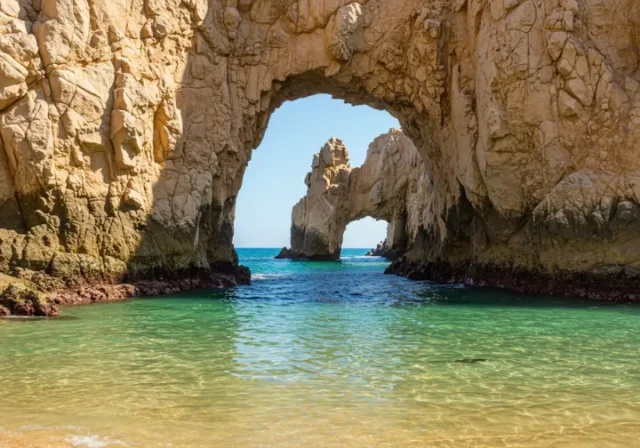In this article
Planning to chase the prized rooster fish in cabo san lucas? Key spots for this incredible fish are inshore, typically within five miles of Cabo San Lucas. Palmilla Point and Chileno Bay are popular locations. Early mornings and late afternoons offer the prime fishing times. Slow-trolling live mullet or sardines works wonders for catching a rooster. Use medium-heavy gear with a 30-50 lb. line. Don’t forget your Mexican fishing license; the limit is two roosterfish per person. Patience is essential, so study the beaches, watch for frigatebirds, and be ready to strike! Persistence pays off.
Understanding Roosterfish Habits
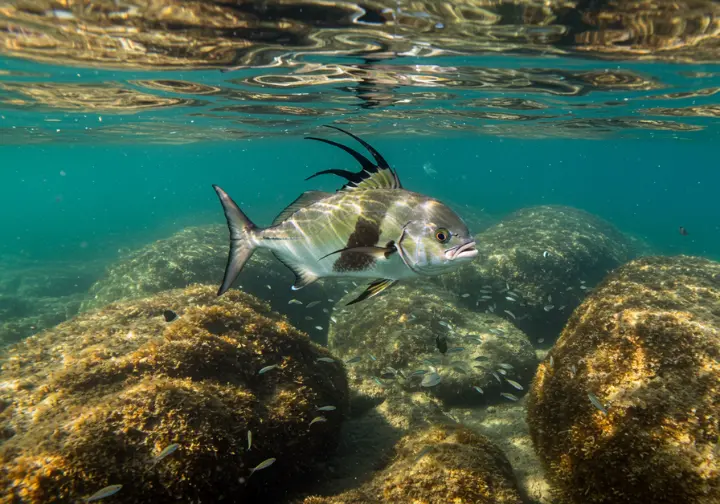
You’re probably wondering where these cool-looking fish hang out, right? We’ll get into their favorite inshore spots and uncover what makes these areas prime real estate for roosterfish. We can investigate their main hunting strategies, so you can better predict their next move. Roosterfish dominate at Los Frailes Beach from December to April, making it a top seasonal hotspot.
Preferred Inshore Habitats
Roosterfish are picky regarding where they hang out, so comprehending their favorite inshore spots is key to finding them. When you’re after roosterfish in cabo san lucas or maybe san jose del cabo, target rocky coastlines and reefs. These areas offer ambush points for these predators. Sandy beaches close to deeper water likewise hold roosterfish. Nearshore fishing along these beaches can quickly lead to hookups, since they may be actively searching for baitfish.
Surf zones are awesome as waves concentrate baitfish. Watch for that too. River mouths can be prolific, especially during tidal changes when baitfish gather. Using live bait is key in those zones. If you are seeking roosterfish fishing with competent roosterfish guides or seasoned captains in cabo sportfishing, coastal points, should be your first option.
Key Predatory Behaviors
To successfully target roosterfish, you’ve gotta understand their predatory habits. Roosterfish are visual predators, and they love baitfish species like sardines & mullet. You might see a feeding rooster near San Lucas, but sometimes these spooky fish are picky, ignoring your presentation.
Recognize because roosterfish often move in schools. If you reel Baja roosterfish, chances are others hang around. You’ll want to plan your roosterfish fishing trip in shallow inshore waters for your best shot, similar to how marlin fishing in Cabo thrives near depth finder-marked hotspots.
Despite sometimes being selective, voracious roosterfish strike hard, testing your gear. Be ready for forceful runs and acrobatic jumps. Knowing how these fish move is key to landing a trophy! Being patient, observant and adaptable is the secret to making them strike.
Locating Prime Roosterfish Spots
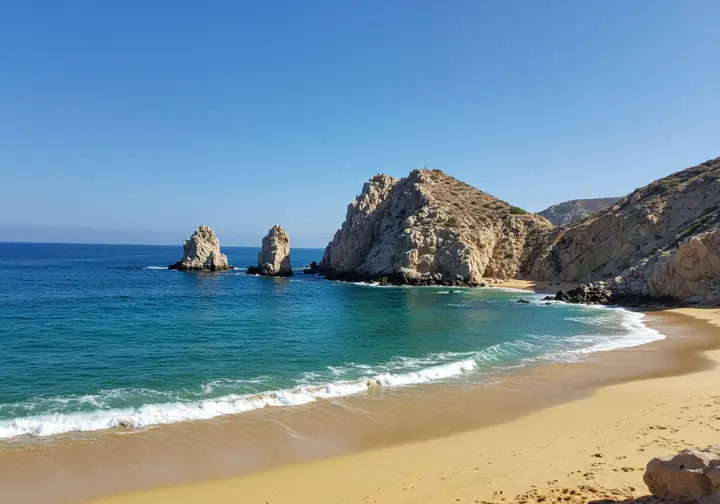
You’re ready to find those trophy roosterfish, aren’t you? We’ll pinpoint specific spots where these beauties lurk. You’ll learn how to identify productive zones which consistently hold fish, improving your chances for an unforgettable catch. Focus on inshore fishing areas within five miles of shore for the best roosterfish action.
Top Specific Locations
Prime roosterfish territory abounds around Cabo San Lucas, Mexico, each offering unique features which enhance your chances of hooking this iconic gamefish. Palmilla Point‘s shallow waters teem with rooster fish cabo san lucas chasing bait. Chileno Bay provides sight fishing in clear waters, so bring your polarized sunglasses. The East Cape fishing region, less crowded, produces big roosterfish; they’re perfect for roosterfish trips. Surfcast at Playa Solmar near Land’s End.
Fish near the Old Lighthouse and Pedregal’s underwater structure, aiming for the north end. Diamante Hard Rock area is incredible since big roosterfish frequent it, so consider cabo san lucas fishing there in July. Finally, Jason Beach has a steep drop-off, allowing easy access to deeper water. Recollect to book your fishing charters early. Matching lure and bait is crucial for enticing roosterfish in these prime spots.
Identifying Productive Zones
So you want to locate some roosterfish? When surf fishing, focus on beaches backed by rocky points or steep drop-offs for access to deep water. Think Old Lighthouse or Diamante; spots where roosterfish reside. Look for troughs running parallel to the beaches; these act as travel lanes for a chance to land fish list roosterfish.
Points jutting into the water attract baitfish and, naturally, roosterfish. You’ll find them at current breaks and eddies. Watch for changes in water color. Clearer meeting murkier spots can be gold on the beaches of Cabo San Lucas.
Breaking waves over sandbars? Cast some lures there. They can trap baitfish and trigger aggressive feeding behavior on these cabo san lucas beaches. Target rising tides as they bring more fish closer to shore, increasing your chances of hooking a roosterfish.
Optimal Roosterfish Timing
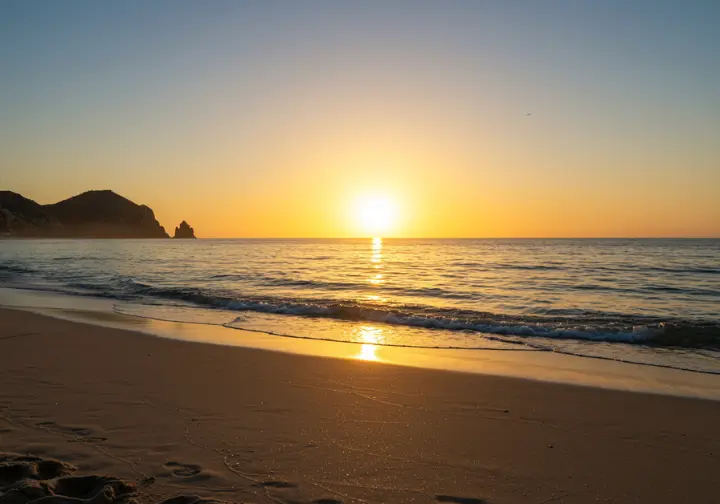
To hook more roosterfish, you’ve gotta nail the timing! We’ll uncover peak seasons when these bad boys are most active and hungry. Plus, you’ll learn the best times of day to hit the water for maximum roosterfish action. March falls within the dry season, prime time for reeling in roosterfish.
Peak Fishing Seasons
Recall, you can locate nematistius all year, despite the late summer and earlier fall will give you the prime action. Now’s the time to reserve those boat trips for cabo! Get in on the angling action. The Sea of Cortez offers nutrient-rich waters that attract roosterfish year-round.
Best Daily Timeframes
Now since you’re locking in your cabo boat trips for peak roosterfish angling, we should discuss best daily timeframes. You’ll find these early mornings and late afternoons are your golden windows for cabo san lucas fishing.
During these cooler, low-light conditions, these roosterfish often cruise right into the shallows. They’re hunting aggressively, particularly for specific baitfish patterns. Dawn and dusk sees them smashing surface lures; think poppers, for exciting action. Increased baitfish action helps, too!
While morning and evening are fantastic, you might still hook into these unique fish during midday, especially if there’s a hefty current or concentrated baitfish. Don’t overlook tides either as peak feeding could align with tides. We’re after heavy fish! You can find charter fishing deals which fit these peak times, though the prices for roosterfish in cabo san lucas can range anywhere from about $788 to $3,153. For the best experience, consider private boats for a more personalized and focused fishing trip. Recollect fishing season regulations and go get your cabo trophy fishing and admire since rooster comb in the sunlight!
Mastering Roosterfish Techniques
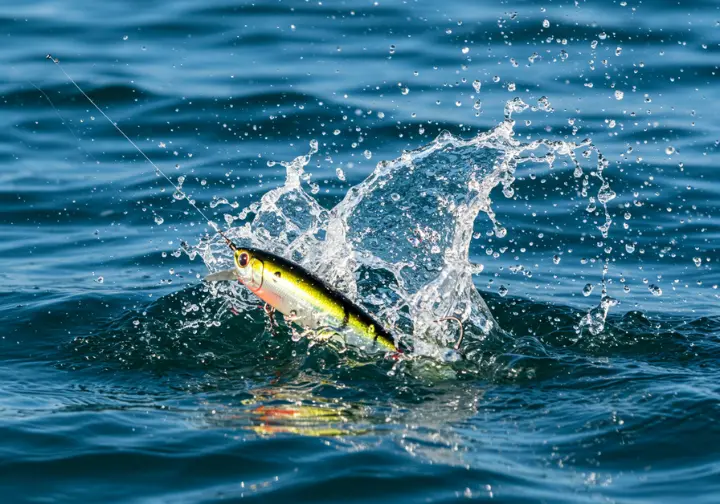
You’re after roosterfish, and we’ve got the goods on how to hook ’em. You’ll discover killer methods for live bait, plus lure and fly-fishing secrets. Let’s unlock the keys to surfcasting success too! When using live bait, cut mullets are a versatile choice that attract a variety of species.
Effective Live Bait Methods
If you’re serious about hooking into roosterfish, especially the trophy-sized battlers, live bait is your go-to method as nothing beats the real deal when enticing these predators. We all know roosterfish love a struggling baitfish! When san lucas fishing, your weapon of choice should be either mullet or sardines.
You’ll want to rig your live bait correctly by using a bridle rig. Or, you can try passing a circle hook through the baitfish’s nose. Are you fishing from a panga? Try slow trolling just beyond the surf line of cabo san. Bear in mind: maintain a slow trolling speed for the most natural presentation. Keep an eye on your bait. If your baitfish gets jittery, a roosterfish could be nearby. For those huge roosterfish, use bonito!
Successful Lure Fishing Strategies
Even though live bait can be irresistible, you shouldn’t overlook the excitement of fooling roosterfish with lures! You’ll want to cast large poppers, six to nine inches, to mimic their prey. Aggressive, erratic retrieves are key, splashing the lure to grab the rooster’s attention. Swimbaits work if they’re deeper. When they’re holding near structure, drop heavy metal jigs (seven to twelve ounces).
If a rooster misses, recast immediately! Locally favored lures, like the “Cabo Killer,” can give you an edge. Having a diverse selection is smart; think knife jigs, pencil poppers, and trolling plugs from the boat. You won’t use your fly rod here, but you’ll catch tuna and check off your fish list, maybe even snagging a cabo vip outing near San Juan. Don’t let your San Diego fishing stay in San Diego!
Fly Fishing Approaches
Since fly fishing for roosterfish is particularly popular and viable in Cabo, especially along the East Cape’s beaches on the Sea of Cortez side, we’re going to tell you that the prior area offers excellent opportunities for sight casting to cruising fish directly from the shore, thanks to clear, warm waters enhancing visibility for the prior exciting method. You’ll want a stout 9-foot, 10 or 11-weight fly rod and a quality saltwater reel.
For fly line, a tropical intermediate sinking-tip‘s best. Your fly patterns should mimic local baitfish; think large streamers, like Deceivers, and Clouser Minnows. With sight casting, you’ve got to make accurate casts and strip-set hard! Don’t lift that rod tip. A quick fly change can sometimes turn lookers into biters. Some guides may use teasers to bring the roosterfish closer.
Surfcasting Keys to Success
To effectively reach roosterfish from shore and handle their might, surfcasting demands specialized gear. You’ll need a 10-13 foot medium-heavy rod with a high-capacity, fast-retrieve spinning reel. Braided line (50-65 lb) is essential, along with a 60-80 lb monofilament leader. Recall your fishing license; you don’t want trouble with authorities in San Jose!
Now, huck that bait beyond the surf and retrieve quickly. Expect a crazy fight once that roosterfish hits – they’ll flash that dorsal fin like a sailfish! If you miss a strike, recast immediately. Folks near Padre Island fishing additionally use the “bait and switch.” Think you’ll hook a wahoo or blackfin tuna? Unlikely, but you might encounter a shark, spadefish, or something else. Recall safety first and happy fishing!
Essential Gear Recommendations
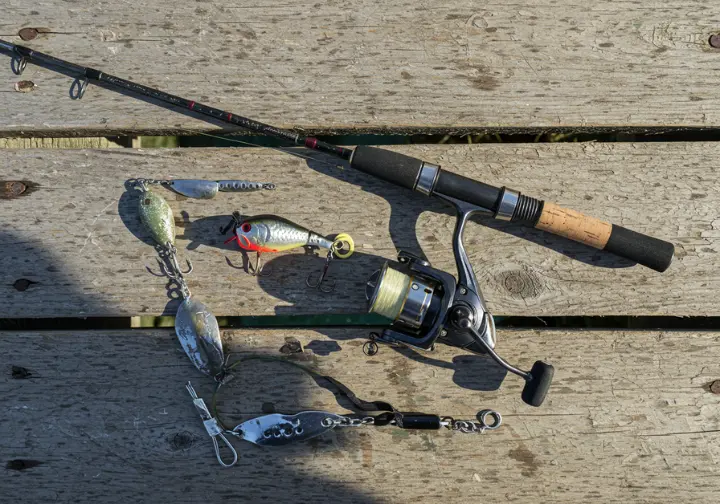
You can’t tackle roosterfish without the right gear, believe me. We’ll break down the rod and reel setups that’ll give you the edge, plus the lines, leaders, and hooks which won’t let you down. Let’s additionally talk about top lure and fly choices to seal the deal.
Rod and Reel Setups
Choosing the right rod and reel setups can significantly influence your success and enjoyment when rooster fishing in Cabo San Lucas. If you’re on a boat, target roosterfish with live bait or lures with medium-heavy conventional/spinning rods, suited for 30-50lb line. You’ll need the backbone for stellar hooksets. For surfcasting, 10 to 13-foot graphite-composite rods rule, allowing long casts. Match it with high-capacity spinning reels.
If fly fishing is your thing, then a 9-foot, 10/11-weight fly rod is best. If chasing fish in deeper water, go with stronger conventional rods rated for 30-50lb. These rods bring the strength to pull fish clear of structures.
Lines, Leaders, and Hooks
Since lines, leaders, and hooks are your direct link to landing this magnificent roosterfish, the angler will admire wanting to carefully consider your selection. For surfcasting, spool up with about 300 yards of 50 to 65-pound test braided line. The angler will admire its strength and casting distance. Add a 60 to 80-pound test monofilament leader and a strong swivel.
For fly fishing near jupiter fishing charters, use a tropical intermediate sinking-tip fly line. Fluorocarbon leaders and tippets work great in the 20 to 40-pound range, plus 300 yards of 50-pound backing. If pesky sierra mackerel show up, consider a short wire leader; they can slice through mono easily, but it’s a tradeoff since roosterfish might spot this. Circle hooks are your best bet for live bait, ensuring better hookups and safer releases. If you’re headed near venice fishing charters, tampa fishing charters, pensacola fishing charters, or destin fishing charters, these setups slay.
Top Lure and Fly Choices
Getting roosterfish to strike requires the right arsenal, and with a variety of lures and flies in your tackle box, you’ll be prepared for any situation. For surface action, pack large poppers and stick baits (6-9 inches) mimicking sardines or mullet. Heavy metal jigs (7-12 ounces) in silver or blue are vital for deeper water. Swimbaits matching local baitfish profiles are likewise effective.
If you are fly fishing, bring 4-6 inch streamers and poppers imitating mullet or sardines are key; Deceivers and Clouser Minnows are proven performers. Don’t ignore what locals use – the “Cabo Killer” popper might be your secret weapon. Finally, having versatile lures like knife jigs, pencil poppers, and trolling plugs lets you adapt to changing conditions, increasing your odds of success.
Following Rules and Tips
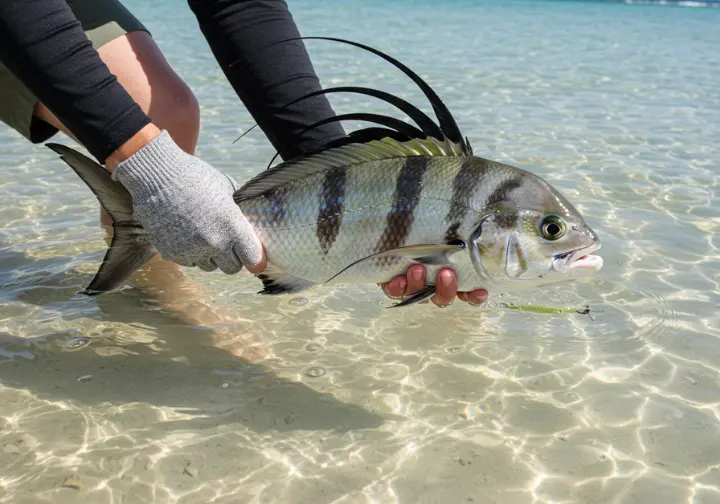
You’ll need to know the local fishing rules and soak up some expert tips if you want to land roosterfish. Wouldn’t you agree it’s important to match your fishing trip to your skill level by deciding between a DIY try, or hiring a guide? We’re going to look at some things which’ll keep you on the right side of the law and increase your chances of success.
Essential Fishing Regulations
What must you do to guarantee you’re fishing by the book in Cabo San Lucas? First, you’ve gotta snag a Mexican sport fishing license; it’s crucial, regardless of where you’re casting from. Many charter operators can hook you up.
Next, recall the roosterfish rules. You’re allowed a max of two per day, and those count as five in relation to your overall ten-fish limit! The general limit is ten fish, no more than five of one specie. Those roosters better be for personal use, selling is a big no-no. You simply can’t use nets or explosives.
If you are keeping your catch, leave the fish whole. Filleting on the boat is dicey. Be careful, a bunch of sea creatures are off-limits! Sea Turtles, clams, and endangered totoava? Let ’em swim.
Valuable Expert Advice
Now we’re diving into advice which will set you apart from the crowd, mixing hard-won secrets with the rules you’ve already learned. You’ll keep an eye out for frigatebirds diving; they’re a dead giveaway for baitfish and roosterfish. Master the “bait and switch” – it’s killer when they miss the first strike.
When fly fishing, don’t strip the fly at the fish; lead it away to trigger a chase. Recall, roosterfish have great eyesight and explosive takes. Patience is key; bigger fish are warier. Capitalize on local knowledge; guides know the hotspots. Look for troughs, points, and waves over sandbars since they signal prime water. You’ll recognize they commit with speed. If you are persistent, the reward justifies the pursuit.
DIY vs Guided Considerations
While hitting Cabo’s roosterfish scene on your own sounds like pure freedom, think about what’s at stake. DIY’s doable, especially if you’re comfy with beach fishing or renting pangas. ATVs can similarly help you scout along the coast. You’ll get maximum flexibility but consider that:
Going guided boosts your odds, big time. Guides know the spots, the bait, and the tricks, like the bait-and-switch. They’ve got the live bait nailed. Sure, it costs more, but it ups your chances of landing a trophy rooster. Plus, guides coordinate team tactics like teasing fish into casting range which is difficult to pull off solo. Book in advance, though – they fill up fast. The choice is yours, experience, budget, and goals considered, but for the best shot at a monster? Hire a guide.
Your Cabo Roosterfish Plan
The reality is clear: a haphazard approach won’t cut it if you’re serious about tangling with a Cabo roosterfish. You’ve gotta have a solid plan. First, you’ll be aiming for rocky shores, reefs, and those sandy drop-offs – spots where roosterfish love to nail their prey. Time it right; May to July is prime, but bigger fish lurk later. Early mornings and late afternoons are gold for surface action.
Now, how are you gonna hook ’em? Live bait (sardines or mullet) with circle hooks is killer, or you can rip big poppers and stick baits. If fly fishing’s your thing, gear up! You’ll want tough rods, reels with serious drag, and strong lines. Don’t forget your Mexican fishing license and stick to the bag limits. Catch and release is the way to go.
Finally, tap into local knowledge. Study those beaches, watch the birds. If you’re unfamiliar with Cabo, a guide will be your best bet. Recall, once you hook one, it’s gonna be a brawl, so guarantee those knots are tight!
Popular Questions
What Currency Should I Use in Cabo San Lucas? +
What Are Some Family-Friendly Activities Besides Fishing? +
What Is the Local Emergency Contact Number? +
Are There Any Venomous Creatures I Should Be Aware Of? +
What’s the Tipping Etiquette for Fishing Charters? +
We are a participant in the Amazon Services LLC Associates Program, an affiliate advertising program designed to provide a means for sites to earn advertising fees by advertising and linking to Amazon.com. As an Amazon Associate I earn from qualifying purchases. We also participate in other affiliate programs. The information provided on this website is provided for entertainment purposes only. We make no representations or warranties of any kind, expressed or implied, about the completeness, accuracy, adequacy, legality, usefulness, reliability, suitability, or availability of the information, or about anything else. Any reliance you place on the information is therefore strictly at your own risk. Additional terms are found in the terms of service.


